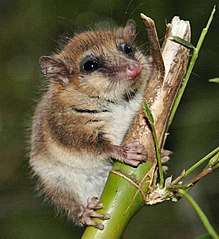Microbiotheria
Microbiotheria is an australidelphian marsupial order that encompasses two families, Microbiotheriidae and Woodburnodontidae,[1] and is represented by only one extant species, the monito del monte, and a number of extinct species known from fossils in South America, Western Antarctica, and northeastern Australia.[2]
| Microbiotheres | |
|---|---|
 | |
| Dromiciops gliroides | |
| Scientific classification | |
| Kingdom: | Animalia |
| Phylum: | Chordata |
| Class: | Mammalia |
| Infraclass: | Marsupialia |
| Superorder: | Australidelphia |
| Order: | Microbiotheria Ameghino, 1889 |
| Families | |
|
Microbiotheriidae | |
Although once thought to be members of the order Didelphimorphia (the order that contains the Virginia opossum), an accumulation of both anatomical and genetic evidence in recent years has led to the conclusion that microbiotheres are not didelphids at all, but are instead most closely related to the Australasian marsupials; together, the microbiotheres and the Australian orders form the clade Australidelphia which are now thought to have first evolved in the South American region of Gondwana.
Biogeography
The oldest microbiothere currently recognised is Khasia cordillerensis, based on fossil teeth from Early Palaeocene deposits at Tiupampa, Bolivia. Numerous genera are known from various Palaeogene and Neogene fossil sites in South America. A number of possible microbiotheres, again represented by isolated teeth, have also been recovered from the Middle Eocene La Meseta Formation of Seymour Island, Western Antarctica. Finally, several undescribed microbiotheres have been reported from the Early Eocene Tingamarra Local Fauna in northeastern Australia; if this is indeed the case, then these Australian fossils have important implications for understanding marsupial evolution and biogeography. The distant ancestors of the monito del monte, it is thought, remained in what is now South America while others entered Antarctica and eventually Australia during the time when all three continents were joined as part of Gondwana.[3][4]
References
- Goin, F. J.; Zimicz, N.; Reguero, M. A.; Santillana, S. N.; Marenssi, S. A.; Moly, J. J. (October 2007). "New marsupial (Mammalia) from the Eocene of Antarctica, and the origins and affinities of the Microbiotheria". Revista de la Asociación Geológica Argentina. 62 (4): 597–603. ISSN 1851-8249. Retrieved 2017-02-12.
- Gardner, A.L. (2005). "Family Microbiotheriidae (p. 21)". In Wilson, D.E.; Reeder, D.M (eds.). Mammal Species of the World: A Taxonomic and Geographic Reference (3rd ed.). Johns Hopkins University Press. p. 21. ISBN 978-0-8018-8221-0. OCLC 62265494.
- Schiewe, Jessie (2010-07-28). "Australia's marsupials originated in what is now South America, study says". LATimes.Com. Los Angeles Times. Retrieved 2010-08-01.
- Nilsson, M. A.; Churakov, G.; Sommer, M.; Van Tran, N.; Zemann, A.; Brosius, J.; Schmitz, J. (2010-07-27). Penny, David (ed.). "Tracking Marsupial Evolution Using Archaic Genomic Retroposon Insertions". PLOS Biology. Public Library of Science. 8 (7): e1000436. doi:10.1371/journal.pbio.1000436. PMC 2910653. PMID 20668664.